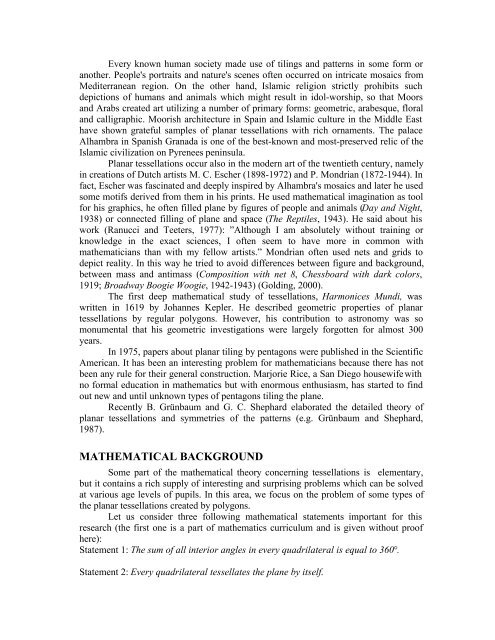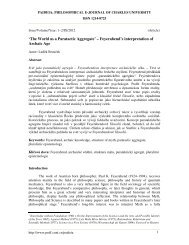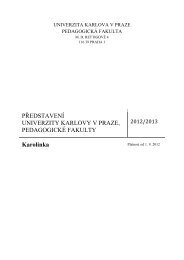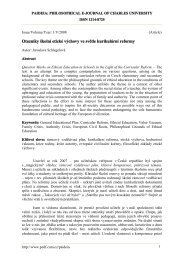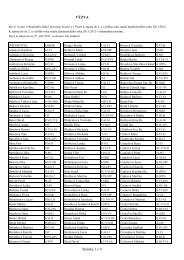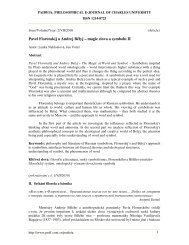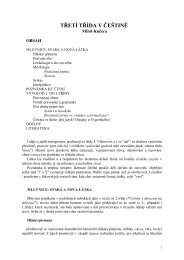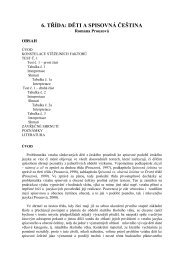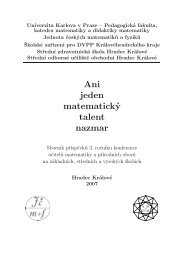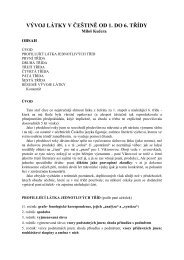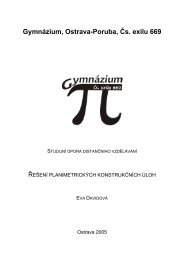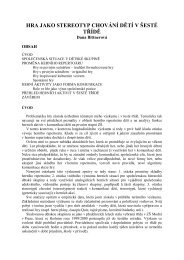Tessellations by Polygons in Mathematics Education
Tessellations by Polygons in Mathematics Education
Tessellations by Polygons in Mathematics Education
Create successful ePaper yourself
Turn your PDF publications into a flip-book with our unique Google optimized e-Paper software.
Every known human society made use of til<strong>in</strong>gs and patterns <strong>in</strong> some form or<br />
another. People's portraits and nature's scenes often occurred on <strong>in</strong>tricate mosaics from<br />
Mediterranean region. On the other hand, Islamic religion strictly prohibits such<br />
depictions of humans and animals which might result <strong>in</strong> idol-worship, so that Moors<br />
and Arabs created art utiliz<strong>in</strong>g a number of primary forms: geometric, arabesque, floral<br />
and calligraphic. Moorish architecture <strong>in</strong> Spa<strong>in</strong> and Islamic culture <strong>in</strong> the Middle East<br />
have shown grateful samples of planar tessellations with rich ornaments. The palace<br />
Alhambra <strong>in</strong> Spanish Granada is one of the best-known and most-preserved relic of the<br />
Islamic civilization on Pyrenees pen<strong>in</strong>sula.<br />
Planar tessellations occur also <strong>in</strong> the modern art of the twentieth century, namely<br />
<strong>in</strong> creations of Dutch artists M. C. Escher (1898-1972) and P. Mondrian (1872-1944). In<br />
fact, Escher was fasc<strong>in</strong>ated and deeply <strong>in</strong>spired <strong>by</strong> Alhambra's mosaics and later he used<br />
some motifs derived from them <strong>in</strong> his pr<strong>in</strong>ts. He used mathematical imag<strong>in</strong>ation as tool<br />
for his graphics, he often filled plane <strong>by</strong> figures of people and animals (Day and Night,<br />
1938) or connected fill<strong>in</strong>g of plane and space (The Reptiles, 1943). He said about his<br />
work (Ranucci and Teeters, 1977): ”Although I am absolutely without tra<strong>in</strong><strong>in</strong>g or<br />
knowledge <strong>in</strong> the exact sciences, I often seem to have more <strong>in</strong> common with<br />
mathematicians than with my fellow artists.” Mondrian often used nets and grids to<br />
depict reality. In this way he tried to avoid differences between figure and background,<br />
between mass and antimass (Composition with net 8, Chessboard with dark colors,<br />
1919; Broadway Boogie Woogie, 1942-1943) (Gold<strong>in</strong>g, 2000).<br />
The first deep mathematical study of tessellations, Harmonices Mundi, was<br />
written <strong>in</strong> 1619 <strong>by</strong> Johannes Kepler. He described geometric properties of planar<br />
tessellations <strong>by</strong> regular polygons. However, his contribution to astronomy was so<br />
monumental that his geometric <strong>in</strong>vestigations were largely forgotten for almost 300<br />
years.<br />
In 1975, papers about planar til<strong>in</strong>g <strong>by</strong> pentagons were published <strong>in</strong> the Scientific<br />
American. It has been an <strong>in</strong>terest<strong>in</strong>g problem for mathematicians because there has not<br />
been any rule for their general construction. Marjorie Rice, a San Diego housewife with<br />
no formal education <strong>in</strong> mathematics but with enormous enthusiasm, has started to f<strong>in</strong>d<br />
out new and until unknown types of pentagons til<strong>in</strong>g the plane.<br />
Recently B. Grünbaum and G. C. Shephard elaborated the detailed theory of<br />
planar tessellations and symmetries of the patterns (e.g. Grünbaum and Shephard,<br />
1987).<br />
MATHEMATICAL BACKGROUND<br />
Some part of the mathematical theory concern<strong>in</strong>g tessellations is elementary,<br />
but it conta<strong>in</strong>s a rich supply of <strong>in</strong>terest<strong>in</strong>g and surpris<strong>in</strong>g problems which can be solved<br />
at various age levels of pupils. In this area, we focus on the problem of some types of<br />
the planar tessellations created <strong>by</strong> polygons.<br />
Let us consider three follow<strong>in</strong>g mathematical statements important for this<br />
research (the first one is a part of mathematics curriculum and is given without proof<br />
here):<br />
Statement 1: The sum of all <strong>in</strong>terior angles <strong>in</strong> every quadrilateral is equal to 360°.<br />
Statement 2: Every quadrilateral tessellates the plane <strong>by</strong> itself.


